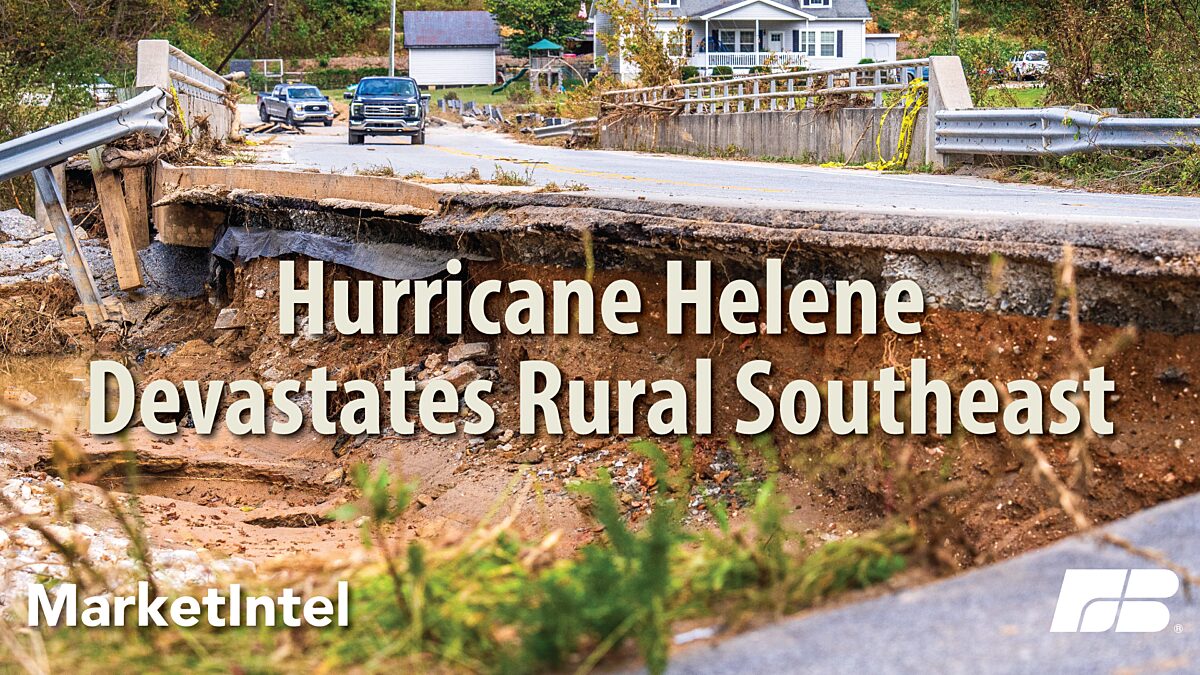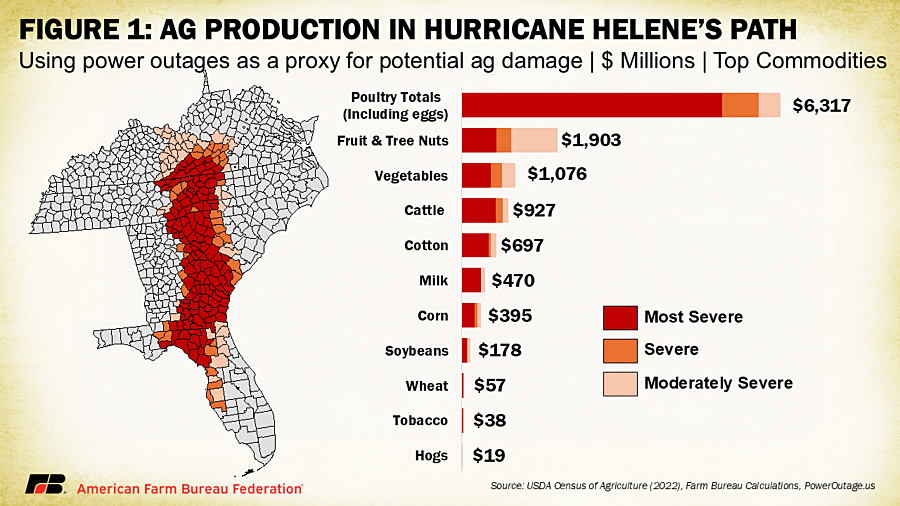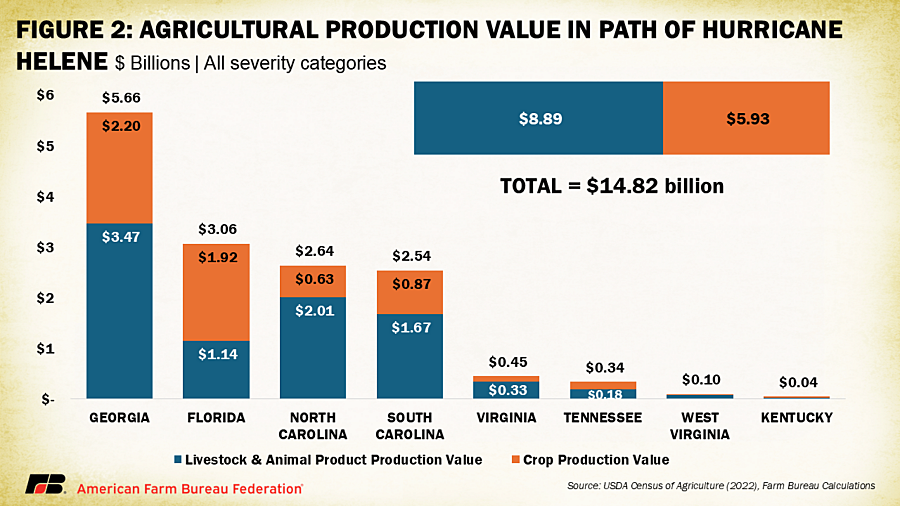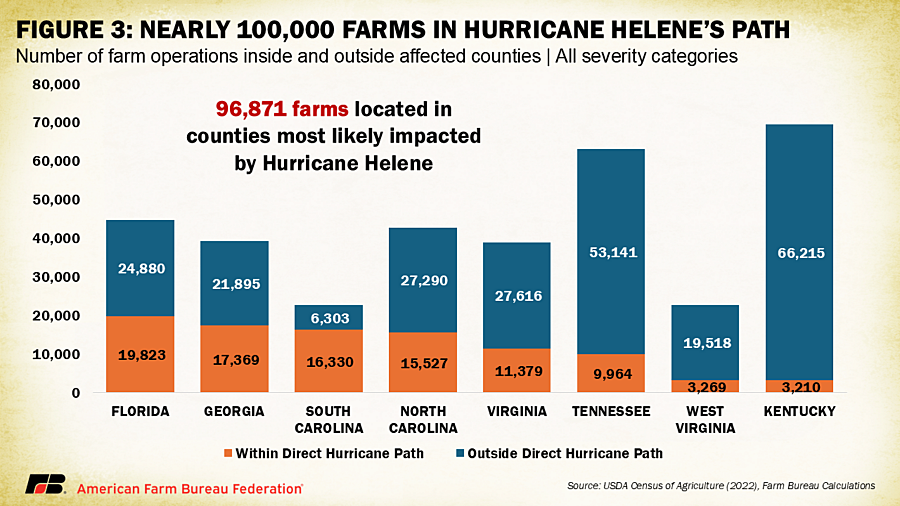Hurricane Helene Devastates Rural Southeast
TOPICS
Hurricane
Daniel Munch
Economist
With over 225 lives lost and many others still missing, Hurricane Helene's devastation will cast a long shadow over affected communities. As the most powerful hurricane ever to strike Florida’s Big Bend region and the deadliest Atlantic storm since Hurricane Maria in 2017, Helene has left these communities not only grieving for lost loved ones but also grappling with the overwhelming challenge of rebuilding their homes, farms, and livelihoods.
Hurricane Helen uniquely affected rural communities, where agriculture is the lifeblood. Farmers have not only lost crops, livestock and essential infrastructure but also friends, family members, and their homes. This article examines long-term challenges rural communities may face as they begin to rebuild. While it’s too early to estimate total agricultural losses, understanding the region's agricultural profile offers a glimpse of what recovery might look like.
For information on how to support victims, please visit our Hurricane Helene Webpage.
Methodology
To assess potential damage, this analysis uses data from the 2022 U.S. Census of Agriculture and overlays it with power outage data from Sept. 28. Power outages are used as a proxy to gauge the most severely impacted areas, with counties categorized as most severe, severe or moderately severe based on the percentage of power loss. While this is not a perfect measure of agricultural damage, it provides a reasonable indicator given the strong correlation between power outages, flooding and wind damage with infrastructure damage and crop losses.
Poultry Hit Hardest by Hurricane Helene
Poultry production is the dominant agricultural industry in the region, with an estimated $6.3 billion in poultry products produced across the affected counties in 2022. Over 80% of the poultry production value is concentrated in the most severely affected counties category. Georgia and North Carolina, which together account for more than a quarter of the U.S. broiler supply by value, were among the hardest hit.
Reports indicate that high winds flattened numerous poultry houses, with Georgia Governor Brian Kemp announcing that over 107 poultry houses were either damaged or destroyed. In Florida, reports suggest that roughly 1 in 7 broiler houses are damaged or destroyed. These losses will not only reduce the immediate supply of poultry but also hinder local production capacity for months or even years. Rebuilding poultry houses, restocking flocks and addressing supply chain disruptions will be costly and time-consuming. Additionally, flooding from the hurricane-contaminated feed and water supplies, increases the risk of disease outbreaks in surviving birds. These environmental and health issues, combined with the financial burden of rising insurance premiums, could force many poultry farmers out of the market.
Fruit and Tree Nuts: Significant Impact to Pecans and Berries
Fruit and tree nut production across the impacted counties totals approximately $1.9 billion annually. Of this, $808 million is attributed to berries, primarily blueberries and strawberries. Georgia, the second-largest blueberry producer in the U.S., grows about $156 million worth of blueberries each year (15% of the nation’s total by value). Florida accounts for 13% of U.S. strawberry production. Many farms experienced extensive flooding of fields that had been prepped with raised beds in plastic for strawberries to be planted in two weeks.
Perhaps even more devastating is the loss of pecan orchards. Georgia is responsible for 36% of U.S. pecan production, with approximately $183 million in annual output from over 260,000 acres. Preliminary reports from the University of Georgia suggest that older pecan trees have suffered a 70% loss, while younger trees face a 40% loss. Affected counties make up about 23% of Georgia’s pecan acreage. The destruction of mature trees, which can take up to a decade to replace, will result in long-term production declines. Additionally, prolonged flooding from the storm has saturated the soil, increasing the risk of root rot and other fungal diseases that could further weaken or kill surviving trees, compounding challenges to recovery. Primary apple growing regions, particularly in North Carolina which supplies over $20 million in fresh market production, have also been impacted, with orchards facing similarly daunting challenges from tree loss and waterlogged soils.
Vegetables: Disease and Rot
Vegetable production in the affected region amounts to $1.1 billion annually. Excessive rainfall and flooding have created perfect conditions for bacterial and fungal diseases to thrive. In South Carolina, mustard greens, rutabagas, tomatoes, and brassicas like broccoli and collard greens have already shown signs of bacterial root rot and blight. This could severely reduce yields and disrupt supply chains, particularly as many of these vegetables are key components of the fall and winter harvest. Cucurbits, including cucumbers and squash, are also susceptible to diseases due to saturated soils.
Adding to the challenge is the impact of federal food safety regulations. Under Section 402(a) of the Federal Food, Drug, and Cosmetic Act, any edible portion of a crop exposed to floodwaters is considered adulterated, with “no practical method of reconditioning the edible portion” to ensure it is safe for human consumption. This means that exposed food crops, such as leafy greens, tomatoes, string beans and berries, and underground crops like peanuts, potatoes, and carrots, cannot be sold. Even crops with hard outer skins or shells, such as winter squash and watermelons, are considered adulterated if exposed. This regulatory requirement amplifies the financial strain on farmers, as large portions of their harvest may be rendered unsellable.
Livestock and Dairy: Destruction of Pasture and Facilities
Livestock, particularly cattle, and dairy production are also major industries in the affected region, with nearly $1 billion in cattle production and $500 million in dairy. Flooding destroyed significant amounts of pastureland, and many farms lost miles of fencing, allowing surviving beef and dairy cattle to scatter. This will increase the cost of recovery as producers will need to repair infrastructure and, in some cases, locate and relocate animals.
Dairy farms were especially hard hit by power outages, which disrupted milking operations and caused large quantities of milk to spoil. In the coming months, producers will face further challenges from reduced feed supplies, as hay stores were contaminated by floodwaters, rendering them unusable. Prolonged exposure to wet and muddy conditions can lead to an increased risk of infections, such as foot rot or mastitis in dairy cows, while the added stress can further reduce milk production.
Row Crops: Cotton, Corn, and Soybeans
The storm also devastated key row crops, including cotton, corn and soybeans. Counties in the affected areas produce nearly $700 million in cotton, $400 million in corn, and $180 million in soybeans annually. Cotton, in particular, had only just begun harvest when Helene hit and is vulnerable to wind damage, with reports of flattened fields and tangled bolls making it difficult to harvest. This will not only reduce yields but also lower fiber quality, further affecting market prices.
Hurricane Helene’s Economic Implications
In total over $14.8 billion in crop and livestock production is generated in the affected counties. Georgia leads with $5.66 billion in production value, followed by Florida at $3.06 billion, North Carolina at $2.64 billion, and South Carolina at $2.54 billion. If just one-third of this output were lost, agricultural damages could reach nearly $5 billion. Early estimates from Florida's Department of Agriculture and Consumer Services indicate between $500 million and $800 million in crop and farm infrastructure losses in Florida alone. Virginia Cooperative Extension has estimated $125 million in agricultural damage in their state. Nearly 100,000 farms operate in the affected counties, underscoring the critical importance of agriculture to the region’s economic health.
Disaster Assistance and Crop Insurance Programs
For farmers affected by Hurricane Helene, federal disaster relief programs will be critical in the recovery process. Programs like crop insurance and various disaster assistance options authorized under the farm bill provide financial support for crop, livestock and infrastructure losses.
Farmers with coverage under the Federal Crop Insurance Program or the Noninsured Crop Disaster Assistance Program should report crop damage as soon as possible. The Risk Management Agency has authorized Approved Insurance Providers to accept delayed notices of loss due to Hurricane Helene, allowing flexibility in accordance with the Loss Adjustment Manual Standards Handbook. These programs offer risk protection for a variety of crops, helping farmers recover some of their lost income due to yield reductions or destroyed crops. However, it’s important to note that not all crops or types of losses are covered. In some cases, farmers may face gaps in coverage, particularly for specialty crops like strawberries
For perennial crops like pecans, the Tree Assistance Program provides additional support. This program helps cover the costs of replanting or rehabilitating orchards when trees are damaged or killed by natural disasters. While crop insurance covers the lost crop, TAP specifically addresses the financial burden of replacing long-lived assets like trees, which take years to mature.
Farmers can also turn to the Emergency Conservation Program and Emergency Forest Restoration Program for assistance in restoring damaged farmland and forestland. These programs provide cost-share assistance to help repair damage to fences, infrastructure and farmland caused by flooding, wind and other hurricane-related events.
Livestock producers impacted by Hurricane Helene can find relief through the Livestock Indemnity Program, which compensates for livestock deaths exceeding normal mortality rates due to extreme weather, covering 75% of the animals’ fair market value. Additionally, the Emergency Assistance for Livestock, Honeybees and Farm-Raised Fish Program provides payments for feed losses and increased transportation costs, offering critical support to producers facing feed and water supply disruptions.
While these programs provide a vital lifeline, recovery will still be a long and difficult process. As farmers file claims and wait for assistance, immediate needs—such as replacing destroyed feed supplies, repairing barns, and managing increased insurance premiums — may push smaller producers to the brink. The ongoing need for improved disaster assistance and insurance support highlights the importance of a modernized farm bill that ensures timely and adequate relief for all types of farmers.
Conclusion
The road to recovery will be long and challenging, as the devastating loss of life, homes and livelihoods will leave lasting scars on these communities. Rebuilding must go beyond restoring physical infrastructure — it must also focus on supporting the mental and economic well-being of the farmers who sustain both their communities and the nation’s food supply.
The full extent of agricultural losses from Hurricane Helene will take time to assess, but it is clear that the storm has severely impacted a region critical to U.S. food production. From poultry and pecans to cotton and cattle, the recovery process will be long and challenging. Federal programs such as crop insurance, the Tree Assistance Program and disaster relief measures authorized by the farm bill will play a vital role in helping farmers rebuild. However, as this event demonstrates, the need for a modernized farm bill to enhance crop insurance, disaster assistance and farm support programs remains pressing.
As recovery efforts from Hurricane Helene continue, the region is bracing for the potential impact of Hurricane Milton, which is expected to make landfall in the coming days, further compounding the challenges faced by these agricultural communities.


